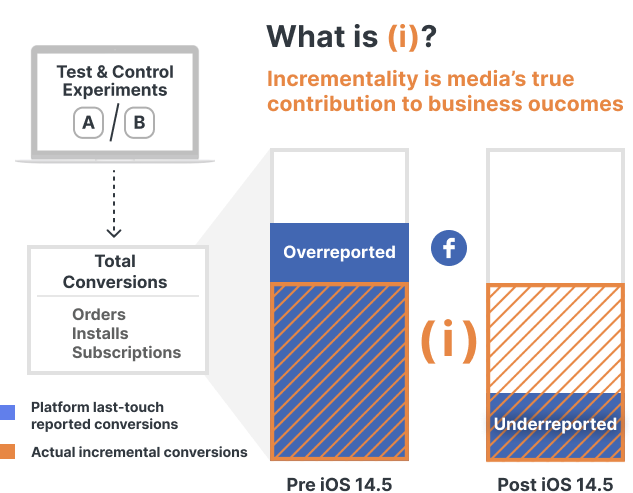When a marketer runs an ad on a platform like Facebook, Facebook takes credit for all of the conversions that ad was in the path of (last-touch attribution). In the past, platforms often took more credit than than they derseved, because last-touch metrics include conversions that still would have happened if they had not seen the ad on Facebook. Today, the opposite is true. Due to anti-tracking measures and shrinking attribution windows, platforms are unable to track all conversions, causing them to now underreport ad performance.Whether a platform is claiming credit for too many or too few conversions, incrementality can reveal the actual number of total conversions that were caused by the media in question.

Why every brand should measure incrementality
Because they don’t have access to all the data outside their own environment, every digital ad platform uses the same flawed last-touch attribution method. Reports provided by ad platforms will never match up with site-side analytics reports or what’s observed in a brand’s sales data. Taking platform reporting at face value is a risky practice that can lead to bad decisions and lost revenue.
Only incrementality can reveal which media investments contribute to business metrics and by how much. Measuring for incrementality identifies where to eliminate waste and surfaces opportunities to scale, expand, and reallocate media spend for maximum growth.
As access to third-party data and user-level tracking end, the accuracy of platform reporting is eroding even further. Measurement that is independent of platform bias and future-proof against the whims of a constantly changing industry is critical for today’s marketers. Incrementality measurement can deliver where methods like last-touch and multi-touch attribution fail.

Use this free calculator to find out how much you can improve ROAS with incrementality measurement
How incrementality is measured
Incrementality is most effectively measured through proven test and control experiment methodology. By withholding the ad or treatment being tested from a statistically significant segment of the intended audience (the control group) marketers can determine the percentage of the target audience that still converts when they are not exposed to the ad. Subtracting that percentage from total conversions by the exposed audience (the test group) results in the actual incremental contribution, or incrementality percentage, of the media in question.
Incrementality measurement can vary in complexity from a simple holdout test as described above to multivariate experiments so elaborate they require the expertise of a trained data scientist. But, when carefully designed and cleanly executed, controlled experiments can utilize data from an unlimited number of sources to reveal the incremental impact of just about anything marketers want to test – on any outcome that can be measured.
CR%
–
CONTROL
CR%

